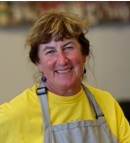
[Note: This article appeared in the Late Fall 2013 Newsletter. The full newsletter can be viewed in this pdf document]
This is the thing about a good meal: it’s like a play. If it’s done right, there’s an enormous amount of hustle and bustle behind the scenes, but all the audience usually sees—and enjoys–is the wonderfulness of the end product. As a result, those behind-the-scenes workers, whether they are costume designers or cooks, don’t always get the recognition they deserve. (all photos by Jim Bucar)
 So let’s hear it for the “lunch ladies” of the ETA’s Maine Lighthouse Ride!— as they jokingly refer to themselves. Though they often go unseen by many of the riders, without them the end of the ride would be a lot less organized, efficient and friendly, and the riders a heck of a lot hungrier.
So let’s hear it for the “lunch ladies” of the ETA’s Maine Lighthouse Ride!— as they jokingly refer to themselves. Though they often go unseen by many of the riders, without them the end of the ride would be a lot less organized, efficient and friendly, and the riders a heck of a lot hungrier.
In 2008 the MLR base of operations moved to Southern Maine Community College (SMCC). Since that time, their leader, Patti Poole, has volunteered to plan, coordinate, and help prepare the end-of-the-ride meal. Mind you, most of the time she was also acting as the overall Volunteer Coordinator, a job she gratefully passed on this past year. Luckily for Patti, and for the MLR, for several years she has had a regular crew of volunteers—Pat Buckley, Cookie Kalloch and Jean Dufour—to make the task, if not easy, fun and well organized.
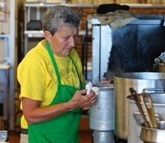 “We’re a well oiled machine,” Patti notes. “The core four of us have been doing it together for so long, we have it down.” Her crew says it’s Patti’s organizational skills that make it all run smoothly.
“We’re a well oiled machine,” Patti notes. “The core four of us have been doing it together for so long, we have it down.” Her crew says it’s Patti’s organizational skills that make it all run smoothly.
None of them remembers exactly when they started volunteering to help with the ETA, and they all became involved via different paths. Some came to the ETA via friends: for Patti it was Carole Brush, executive director of the ETA; Cookie thinks Jean brought her in; while Jean points to John Andrews, President Emeritus of the ETA, as her connection—a chain reaction of volunteerism. Others took a more direct route: Pat says she heard about a trail, thought it was a great idea, and called up the office to ask how she could help.
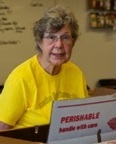 However, all know what first made them want to help the ETA: love of the outdoors and excitement at the idea of a trail that is to be part of a larger pathway stretching from Maine to Florida. All are avid hikers, bikers and/or runners. As an army officer’s wife, Cookie shipped her bike all over the world as she moved around from Europe to Kansas to Massachusetts, and Pat and Jean have hiked several sections of the Appalachian Trail (AT). Jean notes she is proud to have a son and grandson who have hiked the entire AT. Patti describes herself as “outdoorsy” and was on her way to hike a mountain when I caught her on her cell for this interview (note: she was not driving).
However, all know what first made them want to help the ETA: love of the outdoors and excitement at the idea of a trail that is to be part of a larger pathway stretching from Maine to Florida. All are avid hikers, bikers and/or runners. As an army officer’s wife, Cookie shipped her bike all over the world as she moved around from Europe to Kansas to Massachusetts, and Pat and Jean have hiked several sections of the Appalachian Trail (AT). Jean notes she is proud to have a son and grandson who have hiked the entire AT. Patti describes herself as “outdoorsy” and was on her way to hike a mountain when I caught her on her cell for this interview (note: she was not driving).
This love of outdoor recreation and volunteer spirit is reflected in the other volunteer work they do as well, both for the ET and other organizations. Patti is currently the treasurer and membership coordinator for Saco Trails and has served as its president; Jean was vice president of the Maine chapter of the AMC; Pat has hiked several sections of the AT and volunteers frequently for Portland Trails: and Cookie, along with helping with ETA mailings, also speaks 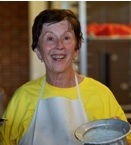 persuasively about the ET at city and town meetings.
persuasively about the ET at city and town meetings.
It’s a good thing they do love the outdoors and have such a strong spirit of volunteerism; they have a 12-hour day ahead of them at each year’s ride.
Their work actually starts months before as Patti begins planning the meal and procuring the ingredients, working with merchants and vendors to get the best price (free/donated is her preference). Then Cookie and Jean join her the night before at SMCC’s Culinary Arts building to help unload a mountain of boxes and shopping bags and set up the kitchen.
By 6 a.m. on the morning of the ride, Patti’s back in the kitchen, making sure there are refreshments available for the volunteers who have braved the early hour to help with the ride start. Cookie and Jean also arrive in the wee hours to help with rider packet distribution. After they and Pat join Patti in the kitchen around 10, the lunch/dinner prep swings into full speed ahead. They stir buckets of soup, chop a garden’s worth of vegetables, and toss mounds of salad, getting ready for the first wave of riders to return.
In the early years of the ride, they also served the meal. Patti notes they’ve been fortunate as the ride has grown to have “more and more volunteers” helping. Students from Interact, one of South Portland High School’s student clubs, have assisted in past years, and this year several seniors from the University of New England served the meal, freeing the “Core Four” to focus their attentions more on the actual cooking. The students’ help was very much appreciated. “I’m very impressed by them,” Jean notes. “They were very good”; the rest of the crew agrees.
Even with the students dishing up the food to the riders, the crew is still kept plenty busy prepping more food to refill the steam table (the chowder was an especially big hit with this year’s riders; last year it was the chili), salad bowls, veggie platters, and drinks. Other volunteers stand in awe of the crew’s stamina, commenting on their energy as they move back and forth among kitchen, dining room, and lobby. This energy is despite (or maybe because of?) the fact that, as Pat puts it, “None of us are spring chickens.”
Everyone’s least favorite chore, washing the dishes, is a part of their work too. One big assist at this year’s ride was finally learning how to operate the Culinary Arts industrial-sized commercial dishwasher. It only took “2-3 years,” Cookie notes wryly. Another accomplishment they are proud of is devising a new method to keep the chowder from scorching. All agree that developing better systems is one of the pleasures of the work. Jean also finds the way the ETA works with volunteers is a draw: “I like to support organizations that use their volunteers well.”
What keeps them working so hard in the kitchen, though, goes beyond that, to something that may have to do as much with the heart as the head. Cookie notes that as a runner in Europe she loved the sense of camaraderie of sharing a meal of brats with fellow runners after a race. She sees that same kind of camaraderie in the riders when they sit down to enjoy a bowl of chowder with someone they may not have known before that day. Cookie also notes that the riders really enjoy the healthy food choices Patti makes: “It’s good to serve food up that people really take to.”
Or as Pat puts it: “It makes me happy to prepare food. There’s a deep connection between feeder and diner, especially after a 100-mile ride.”
Note: There is one aspect of the day’s labor Patti, Cookie, Pat and Jean wouldn’t mind giving up. Their day begins, as noted, at 6 a.m. and often doesn’t end until 6 p.m. or later when they load up vehicles with leftover food and paper goods. It’s a smaller pile than when they started, but after a long day on their feet it can feel pretty heavy. And even with their new found mastery over the dishwasher, the last hour or so of clean up can be, well, a chore. They would love to have some volunteers who could come in “fresh” from about 4 p.m. to 6 p.m. to help with cleanup and loading vehicles. If you’re interested in doing this, please contact Brenda Edmands at bren.edmands@gmail.com or the ETA office at eta@easterntrail.org.
Share this Story:

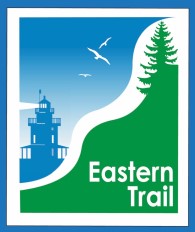
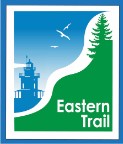
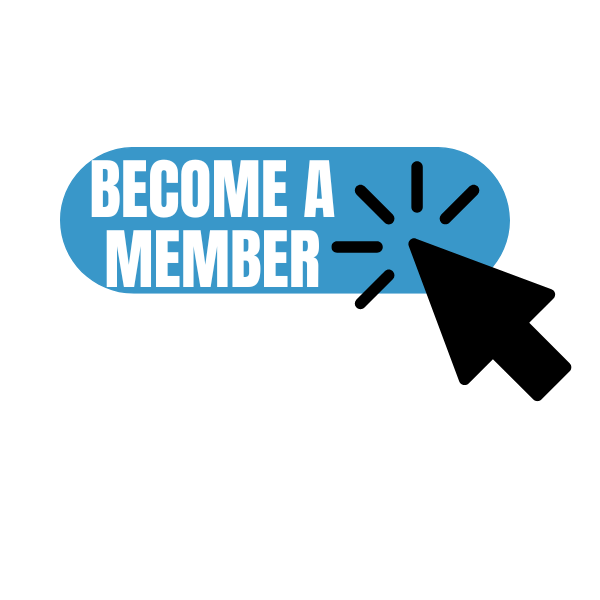








0 comments
Write a comment